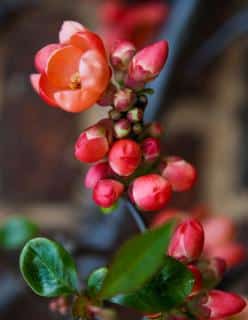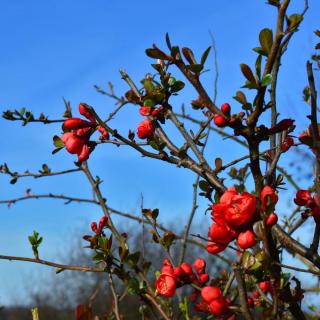

Maule’s quince is a simply beautiful shrub, and its blooming largely contributes to its success.
Key Maule’s quince facts:
Name: Chaenomeles speciosa
Common: Maule’s, Chinese, Japanese quince
Family: Rosaceae
Type: shrub
Height: 3 to 6 ½ feet (1 to 2 meters)
Exposure: full sun, part sun
Soil: ordinary – Foliage: deciduous – Flowering: February to May
Care, from planting to pruning, will enable your Maule’s quince to grow and bloom.

Maule’s quince is an easy shrub that adapts to all types of soil, and to all climates, too.
There are several ways of propagating your Maule’s quince like grafting, sowing or preparing cuttings.
For sowing, best to start in fall or in spring with seeds that you’ll have extracted from the fruits.
For grafting, shield budding over the summer is the way to go.
Finally, preparing cuttings is the most straightforward and quickest solution to multiply Maule’s quince.

Whether in a hedge or planted as as a standalone, Maule’s quince growth is rapid, and it will only take the desired shape if you cut it back regularly.
But it is of course great to let it grow following its natural inclination, it will still look marvelous!
After the blooming, best to perform a light pruning to guide the shrub into the shape you’re hoping for it to grow into.
Maule’s quince fruits aren’t very good to eat raw because they are very astringent. They’ll pucker up your lips like nothing!
But just as for the more traditional quinces, they can be cooked and turned into delicious jelly among other ideas.
Native to Asia, Maule’s quince blooms beautifully in hues of red or rose-purple at the end of winter, which will give many colors to your garden.
It is among the most beautiful flowering shrubs in that part of the season, and also is quite cute during the rest of the year.
Often used in defensive hedges because of its many thorns, its practical purpose is doubled with its ornamental benefit to enhance your garden.
Indeed, after the blooming come fruits which are particularly interesting since their fragrant smell spreads deliciously.
Maule’s quince is a shrub that can hold quite well to the cold and to freezing, since it resists temperatures down to 5°F (-15°C).
<!–silent
–>
Read also:
Maule’s quince is perfectly suited to hedging, but it also grows well in garden boxes on a terrace.